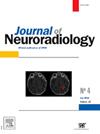单侧大脑中动脉狭窄或闭塞时受损的铁代谢和大脑灌注模式:定量易感图的启示。
IF 3
3区 医学
Q2 CLINICAL NEUROLOGY
引用次数: 0
摘要
背景和目的:大脑中动脉(MCA)狭窄或闭塞引起的脑灌注不足可能会导致铁代谢受损。我们利用定量易感成像(QSM)探讨了慢性单侧大脑中动脉(MCA)狭窄或闭塞患者灰质(GM)核亚区铁变化与不同脑灌注模式之间的关联:招募61名单侧MCA狭窄或闭塞患者,根据相对脑血流(rCBF)测量结果,用Alberta-Stroke-Program-Early-CT-Score(ASPECTS)评分,计算出相应的低灌注亚区数量,然后相应地分为广泛低灌注组(EH组)、区域低灌注组(RH组)和正常灌注组(对照组)。比较各组和三组之间病变侧和对侧的 GM 核团亚区的磁感应强度。进行相关性分析以评估GM核团磁感应强度与平均rCBF、美国国立卫生研究院卒中量表(NIHSS)和改良Rankin量表(mRS)评分的关系:EH组和RH组患者病变侧的丘脑(PU)和苍白球(GP)的磁感应强度高于对侧(P均<0.05)。病变侧 PU 和 GP 的易感性与平均 rCBF 呈负相关,与 NIHSS 和 mRS 评分呈正相关(均 P < 0.05):我们的研究结果表明,慢性脑灌注不足可能是大脑铁代谢异常的原因之一。结论:我们的研究结果表明,慢性脑灌注不足可能是导致大脑铁代谢异常的原因之一,此外,PU 和 GP 的磁感应强度似乎与卒中量表评分相关,这表明铁沉积可能在缺血性卒中后的神经功能缺损中扮演重要角色。本文章由计算机程序翻译,如有差异,请以英文原文为准。
Impaired iron metabolism and cerebral perfusion patterns in unilateral middle cerebral artery stenosis or occlusion: Insights from quantitative susceptibility mapping
Background and purpose
Cerebral hypoperfusion caused by stenosis or occlusion of the middle cerebral artery (MCA) may be followed by impaired iron metabolism. We explored the association between iron changes of gray matter (GM) nuclei subregions and different cerebral perfusion patterns in patients with chronic unilateral middle cerebral artery (MCA) stenosis or occlusion using quantitative susceptibility imaging (QSM).
Methods
Sixty-one patients with unilateral MCA stenosis or occlusion were recruited and scored with Alberta-Stroke-Program-Early-CT-Score (ASPECTS) based on relative cerebral blood flow (rCBF) measurements to calculate the number of corresponding hypoperfusion subregions, and then divided into an extensive-hypoperfusion group (EH group), regional-hypoperfusion group (RH group), and normal-perfusion group (Control group) accordingly. The measured magnetic susceptibility of GM nuclei subregions was compared between the lesion and contralateral side for each group and among the three groups. Correlation analysis was performed to assess the relationships of magnetic susceptibility of GM nuclei with mean rCBF, National-Institutes-of-Health-stroke-scale (NIHSS) and modified-Rankin-scale (mRS) scores.
Results
Magnetic susceptibility in the putamen (PU) and globus pallidus (GP) at the lesion side was higher in the EH and RH groups compared with the contralateral side (all P < 0.05). Susceptibility in the lesion side PU and GP showed negative correlations with mean rCBF and positive correlations with NIHSS and mRS scores (all P < 0.05).
Conclusion
Our findings demonstrate that chronic cerebral hypoperfusion might be one cause of cerebral abnormal iron metabolism. In addition, magnetic susceptibility of PU and GP seems to be correlated with stroke scale scores, suggesting that iron deposition may play an important role in neurologic deficits after ischemic stroke.
求助全文
通过发布文献求助,成功后即可免费获取论文全文。
去求助
来源期刊

Journal of Neuroradiology
医学-核医学
CiteScore
6.10
自引率
5.70%
发文量
142
审稿时长
6-12 weeks
期刊介绍:
The Journal of Neuroradiology is a peer-reviewed journal, publishing worldwide clinical and basic research in the field of diagnostic and Interventional neuroradiology, translational and molecular neuroimaging, and artificial intelligence in neuroradiology.
The Journal of Neuroradiology considers for publication articles, reviews, technical notes and letters to the editors (correspondence section), provided that the methodology and scientific content are of high quality, and that the results will have substantial clinical impact and/or physiological importance.
 求助内容:
求助内容: 应助结果提醒方式:
应助结果提醒方式:


